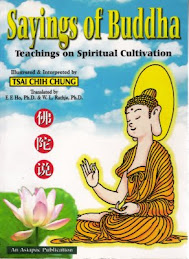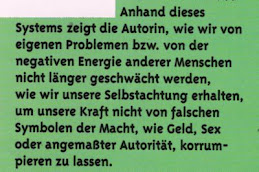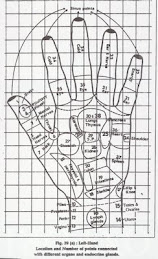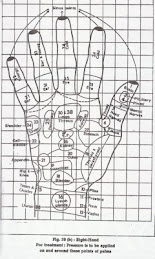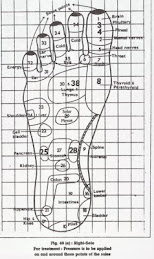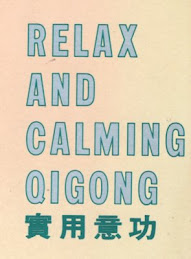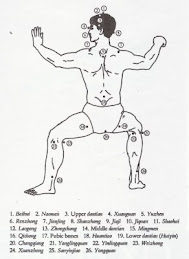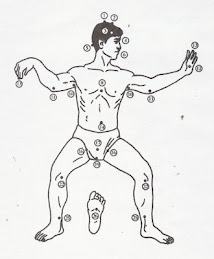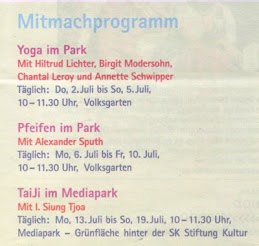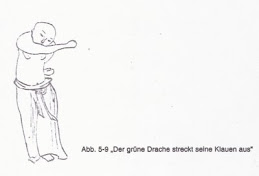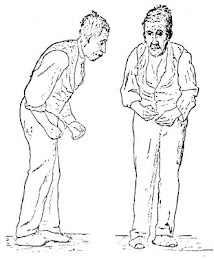Nach der in diesem Blog bereits vorgestellten Dissertation des Schweizer an Parkinson erkrankten Patienten Dr. Mark Hurni, gibt es nun eine zweite Quelle mit hoher Autorität, die frühkindliche Traumatisierung als Ursache späterer Parkinson-Erkrankung erkannt hat.
Dr. Mark Hurnis Forschungsarbeit war eine Dissertation an der Universität Granada im Fach Psychologie, und ist in Spanisch (castellano) geschrieben. Der gesamte Text inkl. Statistik-Teil kann hier im Blog angefordert werden.
Jaclyn Gisburne, Ph.D. in Colorado, U.S.A. wird ihre Forschungsergebnisse auf dem dritten "Parkinson Genesung Gipfel" im Februar 2013 in Santa Fé, New Mexico, U.S.A., zur Diskussion stellen:
Connection Between Trauma and Parkinson's Disease is Profound
Jaclyn Gisburne, Ph.D. from Colorado and I have been corresponding now for four years. The focus of her work is solidly centered on helping people with Parkinson's reverse their symptoms. Dr. Gisburne considers Parkinsons to be a condition of extreme overwhelm of the central nervous system caused by traumatic events and belief systems that were set in place in a persons life at an early age ...
She and her colleagues have identified three specific early traumas that occur prior the onset of Parkinson’s symptoms and a final trauma with the delivery of the diagnosis. These traumatic events result in brain wave distortions that ensure the survival of the person until resolution can be achieved. However, if that resolution is not found, the distortions continue to run through the body, denying access to dopamine reserves. The body becomes exhausted by the stress and continues to decline.
Jaclyn Gisburne will present her research findings about Parkinsons at the Parkinsons Recovery Summit in Santa Fe February. She and her colleague will also offer private neurofeedback sessions (at a 50% discounted rate) to a limited number of persons. If you are interested in securing an appointment with her or her colleague I recommend that you make an appointment with her in advance of the Summit. Her contact information is on the Summit website.
My key suggestion for your recovery is to attend the Parkinsons Recovery Summit in Santa Fe February 21-24th. The people who are reversing symptoms will be there. Are you serious about healing?
Come to the Summit. I guarantee you will not be disappointed.
Parkinsons Recovery Summit
Donnerstag, 17. Januar 2013
Mittwoch, 16. Januar 2013
Gegen Depression: Five Shu Points Akupunktur
Eine neue Studie der Chongqing Medical University, China,. erläutert, inwiefern eine Akupunktur der leicht zugänglichen
Five Liver Shu Points
an den Füßen und Unterschenkeln Depressionen lindern bzw. vermeiden können. Vgl. auch nachfolgenden Post.
Five Liver Shu Points
an den Füßen und Unterschenkeln Depressionen lindern bzw. vermeiden können. Vgl. auch nachfolgenden Post.
Psychosomatische Akupunktur-Punkte
Langjährige Parkinson-Patienten (nach mehr als 10 oder 15 Jahren) kennen die mannigfachen psychosomatischen Symptome, die eines gemeinsam haben: Sie beeinträchtigen den physischen und psychischen Aktiivitätsradius des Patienten. D. h. sie schränken ihn ein und werfen viele seiner Bemühungen auf den Anfangspunkt zurück. Man kann es auch als Regression bezeichnen.
Exakte Selbstbeobachtung erforderlich
Ansetzend an den vom Patienten selbst erfahrenen und identifizierten Symptomen wird im Folgenden ein ganzes System von Akupunktur-Punkten aufgezeigt, die nach der Erfahrung von TCM-Ärzten und -Therapeuten geeignet sind, um auch schwerwiegende Symptome zu lindern. Der Blogger selbst wendet die empfohlenen Akupunktur-Strategien als Akupressur und/oder Elektro-Akupunktur per SEARCH N STIM-Stift erfolgreich an. Quelle:Yin Yang House, Chattanooga, U.S.A.
Quelle:
JOURNAL OF CHINESE MEDICINE NUMBER 42 MAY 1993
THE
FIVE SHU-POINTS by Peter Deadman
Jing-River Points
'Diseases manifesting in the patient's voice'.
Yangxi L.I.-5
Manic speech, mad laughter.
Jiexi ST-41
Melancholy and weeping, Stomach heat with wild raving.
Shangqiu SP-5
Sighing, impaired speech, propensity to laughter.
Lingdao HE-4
Sudden inability to speak.
Yanggu SI-5
Stiffness of the tongue in babies.
Fuliu KID-7
Easily angry with much talking.
Jianshi P-5
Loss of speech.
Zhigou SJ-6
Sudden aphasia.
Yangfu GB-38
Bitter taste with sighing.
Zhongfeng LIV-4
Sighin
Shu-Stream Points - Effect on 'heaviness of the body and pain of the joints'.
Sanjian L.I.-3
Acute stiff neck, redness and swelling of the dorsum of the hand, difficulty in flexing and extending the fingers.
Xiangu ST-43
Swelling and pain of the dorsum of the foot, difficulty in flexing and extending the toes.
Taibai SP-3
Pain of the knee and thigh, joint pains, bone pain, lumbar pain, Wei syndrome.
Houxi SI-3
Stiffness and pain of the head and neck, difficulty in turning the neck, pain of the back and shoulder, pain of the shoulder, elbow and arm, spasm of the elbow, spasm and pain of the fingers, pain of the lower back and knees.
Shugu BL-65
Stiff neck, pain of the lumbar region and back, thigh pain.
Taixi KID-3
Backache, pain and swelling of the heel, swelling and pain of the ankle.
Zhongzhu SJ-3
Inability to extend and flex the fingers, pain of the spine, pain of the elbow, arm and shoulder, numbness of the limbs.
Zulinqi GB-41
Swelling and pain of the feet, pain and spasm of the toes, swelling and pain of the dorsum of the feet.
The Spiritual Axis : Five Shu-Points
Shaoshang LU-11
Mania, childhood fright wind.
Lidui ST-45
Excessive dreaming, severe fright with desire to sleep, inability to sleep, dizziness, mania- depression disorder, aversion to people, likes to ascend to high places and sing, likes to undress and run around.
Yinbai SP-1
Propensity to melancholy, sighing, mania-depression disorder, excessive dreaming, excessive sleeping, acute or chronic fright wind.
Shaochong HE-9
Mania-depression disorder, epilepsy, excessive sighing, excessive anger, fright and worry with insufficiency of Qi.
Yongquan KID-1
Insomnia, aphasia, epilepsy, propensity to fear, anger with desire to kill people, depression with disordered speech and crying and laughing.
Zhongchong P-9
Inability to speak, night-time crying in children.
Guanchong SJ-1
Febrile illness with confused spirit.
Zuqiaoyin GB-44
Excessive dreaming, insomnia, restlessness and anxiety.
Dadun LIV-1
Epilepsy, mania-depression disorder, fondness for sleeping.
LU 3 Acupuncture Point - Tian Fu - Lung Meridian
• Chinese Name Tian Fu
• English Name Celestial Storehouse
• Location: 3 cun below the axillary fold on the radial side of the biceps brachii tendon.
• Precautions: No Moxa.
• Point Associations:
• Window of the Sky Point
• Actions & Effects:
• Window of the Sky Point, regulates head/body Qi flow - goiters, swellings in the neck.
• Lung related spirit disharmonies - stress induced asthma, poor memory, fuzzy/muddled thinking, depression, "floating corpse ghost talk", "melancholy crying ghost talk" (classical descriptions possibly for seeing ghost, talking about ghosts a/or people who have died, being in constant long-term grief about someone who has passed, etc.).
• LV invading the LU pathologies.
• Generally for heat related issues whether from excess or deficiency - nosebleed, coughing blood.
¤ Thirteen Ghost Points (from Sun Si Miao)
Point Number
Point Name
GV 26
Ghost Palace
GV 23
Ghost Hall
GV 16
Ghost Pillow
CV 24
Ghost Market
LU 11
Ghost Faith
LI 11
Ghost Leg
PC 7
Ghost Heart
PC 8
Ghost Cave
ST 6
Ghost Bed
SP 1
Ghost Fortress
UB 62
Ghost Path
Guifeng (Extra Point)
on the underside of
the tongue, one cun from
the tip of the midline
Ghost Seal
Essentially CV 1
originally described as
Yumentou (Extra Point - Women)
/Yinxiafeng (Extra Point - Men)
Ghost Store
UND AUSDRÜCKLICH FÜR PARKINSON-PATIENTEN:
Sky Window Points Theory and Applications
• The Sky Window points are a set of acupuncture points drawn from the Ling Shu.
• Generally they are not popularly used points, although some systems of acupuncture utilize them to a greater degree than others. The basic functions of the points are to improve the flow of energy between the head and the rest of the body.
• The points can be used for local issues such as neck pain, but also more complex issues such as multiple sclerosis and dizziness for example.
• The points are used extensively within the Tom Tam Healing System for a range of conditions such as MS, Parkinsonss, Brain Tumors, etc. - in essence to facilitate the smooth flow of Blood and Qi to and from the Brain.
• The points and their clinical indications are as follows:
◦ ST 9 - regulation of blood pressure, headaches, chest tightness
◦ LI 18 - regulation of blood pressure
◦ TH 16 - sudden deafness, vision disturbances
◦ UB 10 - neck pain, occipital headache, wind-cold invasion
◦ LU 3 - neck pain, goiters, depression, asthma, grief, coughing of blood
◦ CV 22 - throat/vocal cord issues, aphasia, asthma, chest tightness
◦ SI 16/SI 17 - throat issues, goiters
◦ GV 16 - wind-cold invasion, dizziness, tremors, headache, eye issues, aphasia
◦ PC 1 - reflux, hiccups, chest tightness, breast issues, insufficient lactation
Sky Window Points Chart
From Ling Shu
Ch. 21
From Ling Shu
Ch. 2
Renying
ST 9
Tiantu
CV 22
Futu
LI 18
Tianchuang
SI 16
Tianyou
TH 16
Tianrong
SI 17
Tianzhu
UB 10
Fengfu
GV 16
Tianfu
LU 3
Tianchi
PC 1
A c h t u n g !
Über die biophysikalische Funktionsweise der Akupunktur und speziell der elektrischen Akupunktur per Akupunkturstifte (z. B. SEARCH'N STIM oder newgen electronics) sind in diesem Blog neueste Erkenntnisse zusammen getragen. Der Blogger empfiehlt hierzu die Lektüre seiner Ausführungen und Quellennachweise im Posting vom 08.10.2015:
EXKURS mit grafischen Darstellungen und Weblink.
Exakte Selbstbeobachtung erforderlich
Ansetzend an den vom Patienten selbst erfahrenen und identifizierten Symptomen wird im Folgenden ein ganzes System von Akupunktur-Punkten aufgezeigt, die nach der Erfahrung von TCM-Ärzten und -Therapeuten geeignet sind, um auch schwerwiegende Symptome zu lindern. Der Blogger selbst wendet die empfohlenen Akupunktur-Strategien als Akupressur und/oder Elektro-Akupunktur per SEARCH N STIM-Stift erfolgreich an. Quelle:Yin Yang House, Chattanooga, U.S.A.
Quelle:
JOURNAL OF CHINESE MEDICINE NUMBER 42 MAY 1993
THE
FIVE SHU-POINTS by Peter Deadman
Jing-River Points
'Diseases manifesting in the patient's voice'.
Yangxi L.I.-5
Manic speech, mad laughter.
Jiexi ST-41
Melancholy and weeping, Stomach heat with wild raving.
Shangqiu SP-5
Sighing, impaired speech, propensity to laughter.
Lingdao HE-4
Sudden inability to speak.
Yanggu SI-5
Stiffness of the tongue in babies.
Fuliu KID-7
Easily angry with much talking.
Jianshi P-5
Loss of speech.
Zhigou SJ-6
Sudden aphasia.
Yangfu GB-38
Bitter taste with sighing.
Zhongfeng LIV-4
Sighin
Shu-Stream Points - Effect on 'heaviness of the body and pain of the joints'.
Sanjian L.I.-3
Acute stiff neck, redness and swelling of the dorsum of the hand, difficulty in flexing and extending the fingers.
Xiangu ST-43
Swelling and pain of the dorsum of the foot, difficulty in flexing and extending the toes.
Taibai SP-3
Pain of the knee and thigh, joint pains, bone pain, lumbar pain, Wei syndrome.
Houxi SI-3
Stiffness and pain of the head and neck, difficulty in turning the neck, pain of the back and shoulder, pain of the shoulder, elbow and arm, spasm of the elbow, spasm and pain of the fingers, pain of the lower back and knees.
Shugu BL-65
Stiff neck, pain of the lumbar region and back, thigh pain.
Taixi KID-3
Backache, pain and swelling of the heel, swelling and pain of the ankle.
Zhongzhu SJ-3
Inability to extend and flex the fingers, pain of the spine, pain of the elbow, arm and shoulder, numbness of the limbs.
Zulinqi GB-41
Swelling and pain of the feet, pain and spasm of the toes, swelling and pain of the dorsum of the feet.
The Spiritual Axis : Five Shu-Points
Shaoshang LU-11
Mania, childhood fright wind.
Lidui ST-45
Excessive dreaming, severe fright with desire to sleep, inability to sleep, dizziness, mania- depression disorder, aversion to people, likes to ascend to high places and sing, likes to undress and run around.
Yinbai SP-1
Propensity to melancholy, sighing, mania-depression disorder, excessive dreaming, excessive sleeping, acute or chronic fright wind.
Shaochong HE-9
Mania-depression disorder, epilepsy, excessive sighing, excessive anger, fright and worry with insufficiency of Qi.
Yongquan KID-1
Insomnia, aphasia, epilepsy, propensity to fear, anger with desire to kill people, depression with disordered speech and crying and laughing.
Zhongchong P-9
Inability to speak, night-time crying in children.
Guanchong SJ-1
Febrile illness with confused spirit.
Zuqiaoyin GB-44
Excessive dreaming, insomnia, restlessness and anxiety.
Dadun LIV-1
Epilepsy, mania-depression disorder, fondness for sleeping.
LU 3 Acupuncture Point - Tian Fu - Lung Meridian
• Chinese Name Tian Fu
• English Name Celestial Storehouse
• Location: 3 cun below the axillary fold on the radial side of the biceps brachii tendon.
• Precautions: No Moxa.
• Point Associations:
• Window of the Sky Point
• Actions & Effects:
• Window of the Sky Point, regulates head/body Qi flow - goiters, swellings in the neck.
• Lung related spirit disharmonies - stress induced asthma, poor memory, fuzzy/muddled thinking, depression, "floating corpse ghost talk", "melancholy crying ghost talk" (classical descriptions possibly for seeing ghost, talking about ghosts a/or people who have died, being in constant long-term grief about someone who has passed, etc.).
• LV invading the LU pathologies.
• Generally for heat related issues whether from excess or deficiency - nosebleed, coughing blood.
¤ Thirteen Ghost Points (from Sun Si Miao)
Point Number
Point Name
GV 26
Ghost Palace
GV 23
Ghost Hall
GV 16
Ghost Pillow
CV 24
Ghost Market
LU 11
Ghost Faith
LI 11
Ghost Leg
PC 7
Ghost Heart
PC 8
Ghost Cave
ST 6
Ghost Bed
SP 1
Ghost Fortress
UB 62
Ghost Path
Guifeng (Extra Point)
on the underside of
the tongue, one cun from
the tip of the midline
Ghost Seal
Essentially CV 1
originally described as
Yumentou (Extra Point - Women)
/Yinxiafeng (Extra Point - Men)
Ghost Store
UND AUSDRÜCKLICH FÜR PARKINSON-PATIENTEN:
Sky Window Points Theory and Applications
• The Sky Window points are a set of acupuncture points drawn from the Ling Shu.
• Generally they are not popularly used points, although some systems of acupuncture utilize them to a greater degree than others. The basic functions of the points are to improve the flow of energy between the head and the rest of the body.
• The points can be used for local issues such as neck pain, but also more complex issues such as multiple sclerosis and dizziness for example.
• The points are used extensively within the Tom Tam Healing System for a range of conditions such as MS, Parkinsonss, Brain Tumors, etc. - in essence to facilitate the smooth flow of Blood and Qi to and from the Brain.
• The points and their clinical indications are as follows:
◦ ST 9 - regulation of blood pressure, headaches, chest tightness
◦ LI 18 - regulation of blood pressure
◦ TH 16 - sudden deafness, vision disturbances
◦ UB 10 - neck pain, occipital headache, wind-cold invasion
◦ LU 3 - neck pain, goiters, depression, asthma, grief, coughing of blood
◦ CV 22 - throat/vocal cord issues, aphasia, asthma, chest tightness
◦ SI 16/SI 17 - throat issues, goiters
◦ GV 16 - wind-cold invasion, dizziness, tremors, headache, eye issues, aphasia
◦ PC 1 - reflux, hiccups, chest tightness, breast issues, insufficient lactation
Sky Window Points Chart
From Ling Shu
Ch. 21
From Ling Shu
Ch. 2
Renying
ST 9
Tiantu
CV 22
Futu
LI 18
Tianchuang
SI 16
Tianyou
TH 16
Tianrong
SI 17
Tianzhu
UB 10
Fengfu
GV 16
Tianfu
LU 3
Tianchi
PC 1
A c h t u n g !
Über die biophysikalische Funktionsweise der Akupunktur und speziell der elektrischen Akupunktur per Akupunkturstifte (z. B. SEARCH'N STIM oder newgen electronics) sind in diesem Blog neueste Erkenntnisse zusammen getragen. Der Blogger empfiehlt hierzu die Lektüre seiner Ausführungen und Quellennachweise im Posting vom 08.10.2015:
EXKURS mit grafischen Darstellungen und Weblink.
Abonnieren
Kommentare (Atom)



















